Neurofeedback and dyslexia
Day-to-day of a Learning to Learn Course
In January 2011, in the city of São Paulo, the first course in Brazil specifically aimed at addressing dyslexia was conducted. For Dr Tania Valery, a lawyer, and her daughter, Barbara Valery, a student, improvements of around 600% in reading speed and comprehension were achieved. With continued training, other skills will emerge, and what is generally perceived as “dyslexia” simply ceased to exist.
Dyslexia, the Challenge
Alphalearning published in 1996, at the International Conference of EEG and Neurofeedback (USA), the conclusion that dyslexia could be resolved within 10 to 30 hours of training, after testing its system on 500 individuals with dyslexia and recording more than 8,000 EEGs. Alphalearning (which has achieved 100% success with its clients) has also shared numerous scientific studies and articles in internationally recognised journals on its website. These accomplishments remain unmatched by any other research group to date.
The Learning to Learn Course – Practical Results

On the first day of the Learning to Learn Course, we performed standard assessments of reading speed, memorisation, and certain neurological tests. Dr Tania Valery, a lawyer, could read 143 words per minute (wpm) and reported zero comprehension; in her notes, she merely copied parts of the text. Her daughter, Barbara Valery, a student, read at 168 wpm but with minimal understanding.
After three days of preparation using the Brainwave System III, their brains were already balanced enough to learn how to control their brainwaves and experience a new level of performance. Returning to the reading tests, Dr Tania rose from 143 to 430 wpm, while Barbara went from 168 to 400. Comprehension also improved. These were merely initial results, not yet reflecting their true potential. With a bit more training, by the end of the fourth day, Tania reached 630 wpm and Barbara 690 wpm, with a dramatically increased level of comprehension. Both could recount in detail the passage they had read from the middle of an unfamiliar book—on a topic they had never seen before—and their notes were both thorough and sophisticated.
On the last day of the course, Dr Tânia, calmly and confidently, reached an impressive 1,420 words per minute, further enhancing her level of comprehension. Meanwhile, Bárbara, at 840 words per minute, took significantly less than a minute to read a page, maintaining excellent understanding of the content. Our recommendation for anyone who wants to read, understand, and retain what they have read is to do so at their natural speed. This achievement can be attained in as little as five days.
The Scientific Approach – Neurofeedback and Dyslexia
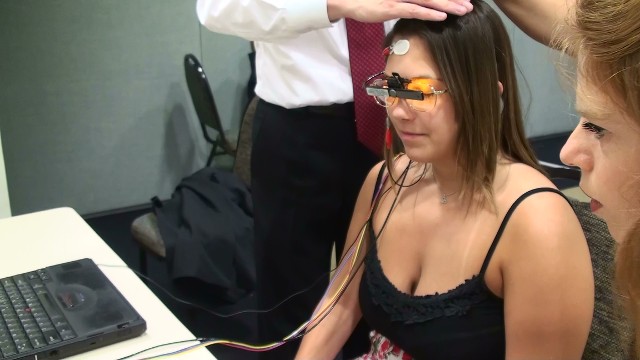
Using the images and explanations below, you will be able to better understand the steps taken in the course with the graduate student, Barbara Valery.
Learn to Read the Next Graph – Brainscape Diagram:
- The rectangle on the left represents the left hemisphere; the one on the right represents the right hemisphere.
- The horizontal axis shows frequencies from 1 to 31 Hz.
- The vertical axis indicates the passage of time: in the example below, a total of just over 3 minutes and 55 seconds.
- The prominence along the horizontal lines measures the intensity of the brain waves at a specific frequency and at a given moment.
- The small numbers 1 to 5 displayed between the two hemispheres are markings placed by the operator to indicate specific points of the test.
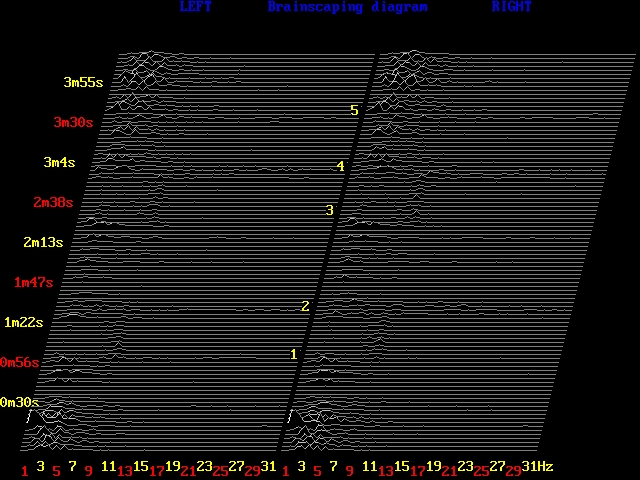
The image on the side shows the results obtained during the first 4-minute test on the first day of the course.
It indicates minimal brainwave intensity across all test activities and all frequencies.
In this case (where no medication was involved), it reflects a long-standing dyslexia condition. The tension caused by the frequency imbalance between the two hemispheres resulted in an almost complete immobility of the brain waves.
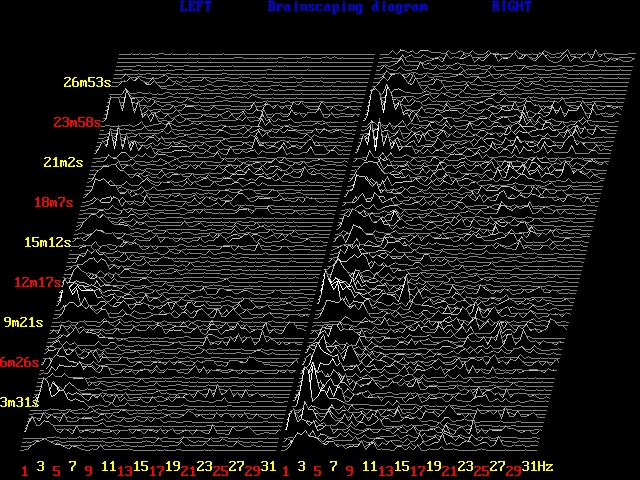
Here we see the outcome of stimulation using the Brainwave System III on the second day of the course.
One of our initial goals was to “wake up” the brain so that its brainwave activity would reach higher intensity levels.
The difference between this image and the previous one clearly shows that Barbara responded to the taught stimuli. She literally woke up – and felt the change.
Learn to Read the Next Plot – Average Frequency Diagram
This Average Frequency Diagram provides an overview of the EEG frequencies recorded in both hemispheres:
- The blue bars represent the left hemisphere, while the red bars represent the right hemisphere.
- The size of each bar (left or right) indicates the intensity of each frequency.
- The vertical axis indicates the central frequency of each bar, ranging from 1 Hz to 30 Hz.
- This chart represents an average of the previous Brainscape diagram, covering the entire measured interval.

In this illustration, we see the same information from the previous diagram, but presented differently.
At every frequency, the intensity of the brain waves is consistently greater in the right hemisphere than in the left.
Classic Dyslexia!
The right hemisphere, responsible for imagination and creativity, exerts dominance, explaining the creativity often found in individuals with dyslexia—paired with the lack of response in areas requiring the left hemisphere or synchronisation between the two (such as reading).
Note that all brain activity above 14 Hz should not be present, given there was virtually no muscle movement during these 30 minutes (Barbara was simply watching a documentary video about Alphalearning and brain research). This heightened activity indicates the presence of brain damage, which people may experience as confusion, lack of focus, learning difficulties, ADHD, or dyslexia (as was the case for Barbara). One of the primary goals during the course is to eliminate this activity above 14 Hz while balancing the amplitude between 1 Hz and 14 Hz. Until this imbalance is addressed, dyslexia cannot be overcome.
Learn to Read the Next Graph – Relative Percentage
- The blue lines represent the left hemisphere, while the red lines represent the right hemisphere.
- The oscillation of these lines is the graphical representation of brain waves in their relative percentages.
- The top pair of lines measures Beta waves exclusively. The middle pair measures Alpha waves, and the bottom pair measures Theta waves.
- The lower horizontal axis indicates the passage of time (in this case, just over 29 minutes and 48 seconds).
- The vertical axis on the right shows the relative percentage of each wave in each hemisphere.
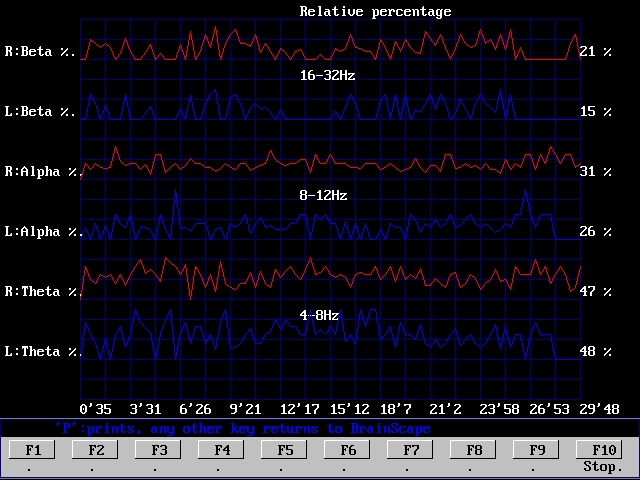
This is another way of viewing the data from the previous two graphs.
Apart from Theta waves, which are close in percentage (47% vs 48%), there is a marked predominance of the right hemisphere in Beta waves (21% vs 15%) and Alpha waves (31% vs 26%).
Theta waves are related to creativity as well as memorisation and recall. Unfortunately, with so much Beta activity and unbalanced Alpha waves, the brain cannot properly receive information. Naturally, one cannot memorise something that never reaches the brain, resulting in a false diagnosis of memory issues—because the person “cannot remember things.”

Focusing on just the end of this reading session we have been analysing, something quite curious appears around the 28-minute mark: the left hemisphere, having already trained, learned, and reconnected sufficiently, decided to rest.
This demonstrates an interesting natural ability we possess: when the brain has done everything it can for the moment, it simply pauses the self-restructuring process so it can absorb all that has happened and continue later. In this instance, that pause occurred solely in the left hemisphere.

Next, we conducted a new reading session lasting almost 15 minutes. After a period of rest and assimilation, a new pattern emerged. The left hemisphere now shows a major surge in activity, overshadowing the previously dominant right hemisphere.

Here we have the same reading session, viewed by its average values. The once underactive left hemisphere is attempting to compensate for years of imbalance, testing out the new skills learned through Brainwave and made possible by newly formed neural connections.
The left hemisphere actually surpasses the right hemisphere’s activity—likely for the first time in Barbara’s life. Without losing any previous talents, she gains additional abilities.

Here are the relative percentages for that same reading session. The left hemisphere (blue lines) is learning to operate across all wave types without having to wait for the right hemisphere. We are still on the second day of the course.
Learn to read the next graph – Absolute levels:
- Blue lines represent the left hemisphere, while the red, right.
- The yellow line measures the balance between the two hemispheres. The more swings, the greater the imbalance.
- The oscillation of red and blue lines is the graphic representation of brain waves.
- The first triplet of lines (above) measures only the Beta waves. The central trio measured waves and the last Alpha Theta waves.
- The bottom horizontal axis measures the passage of time (in this case just over 14min).
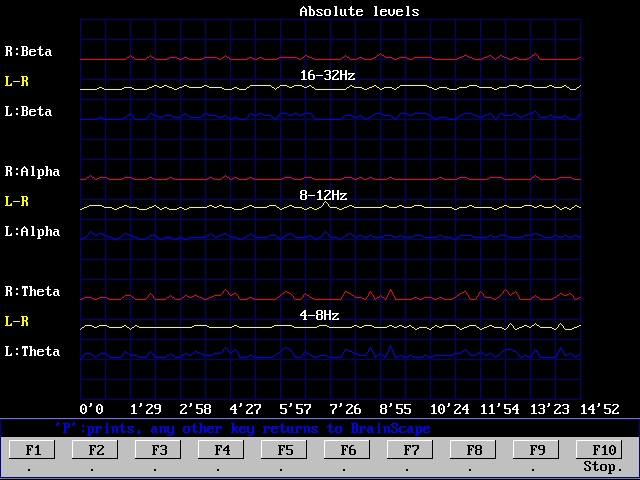
These are the absolute levels for the same reading session as before. This chart compresses the 14 minutes and 52 seconds shown in the previous graphs into a single display. At this level of compression, even a minor fluctuation in the yellow line (which measures the balance between the cerebral hemispheres) is highly significant.
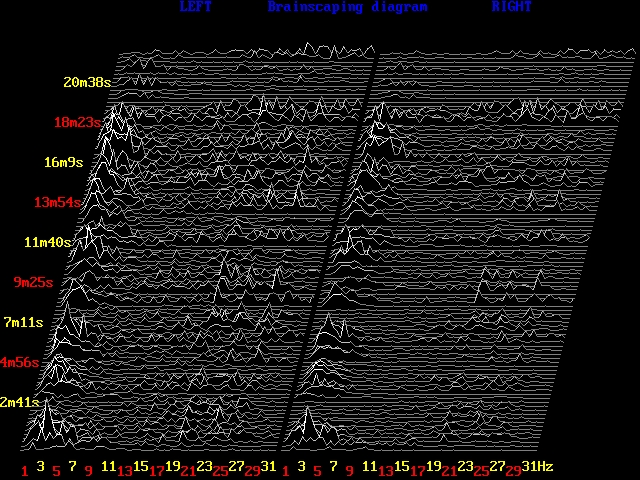
In a new reading lasting 22 minutes and 52 seconds, we still see a predominance of the left hemisphere and numerous Beta waves (above 14 Hz). Notice near the 18-minute mark that both hemispheres sharply reduce their activity.

Here is the same reading session as above, viewed by its average values. The left hemisphere still prevails, and there is considerable Beta wave activity to eliminate.

This is the same reading expressed in relative percentages. Theta waves are getting closer in value, but there is still a noticeable gap in Alpha and Beta waves that needs to be reduced.

Here is that same reading displayed in a different chart. The oscillation of the yellow line over time represents the imbalance between the hemispheres in each of the three main wave types.

Focusing only on the end of that same reading, in close-up, we see the moment when both hemispheres decide to halt their activity and their response to Brainwave stimulation. This marks the end of the second day, followed by a well-deserved (and necessary) rest before the next day.

On the third day, after a good night’s rest, it was time to practise what we had taught the brain during the previous two days: how to enter Alpha state.
According to Michael Hutchison, “only Zen monks with five to ten years of daily, proper meditation can consistently bring their brain waves down to around 9 Hz at will”.
For Barbara, it took just two days. The graph here represents what we call the “Alpha Test”: the person’s ability to
- Enter Alpha (right after the yellow marker between the two hemispheres),
- Relax further and move into Theta (around 3 Hz for periods of 35 seconds to 1 minute),
- Be forced into Beta by an external stimulus, and
- Immediately return to Alpha and remain there.
The level of brainwave control shown in this chart speaks for itself. Simply compare it to the chaotic graphs from previous days.
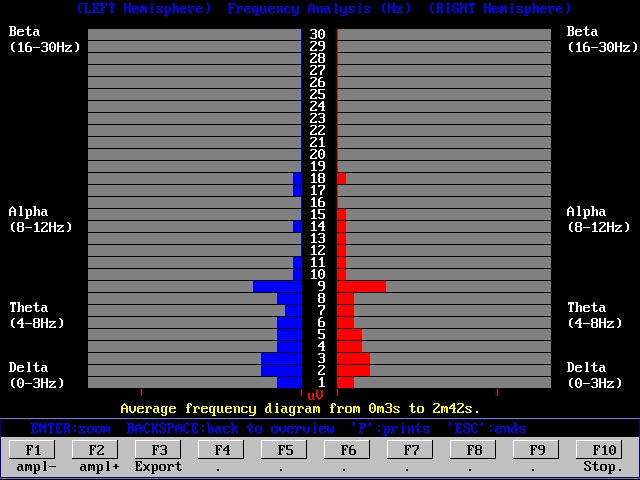
This is the same Alpha Test, seen from an overall average perspective, demonstrating the dominance of Alpha waves around 9 Hz.
It is important to note (1) that waves above 14 Hz have almost completely disappeared, and (2) that the two hemispheres are approaching a true equilibrium.
With the prior Brainwave stimulation, any existing brain damage is diminishing in direct proportion to the disappearance of activity above 14 Hz. (In reality, these high-frequency waves are partially visible here due to an external stimulus we introduced around the first minute.) This stimulus trains the brain’s plasticity, enabling it to shift willingly from one wave state to another and also respond appropriately to external, potentially threatening conditions.

One of the well-researched effects of Alpha waves is the overall balance of the brain.
In this chart of the same test, we see Beta waves with only a 2% difference between the hemispheres, and Alpha waves with a mere 1% difference.
Theta waves still show a difference favouring the left hemisphere. Having identified this, balancing it will be one of our next objectives. We are still on the third day of the five-day course.

Here is a close-up of only the second half of the test—Alpha waves firmly under Barbara’s control.
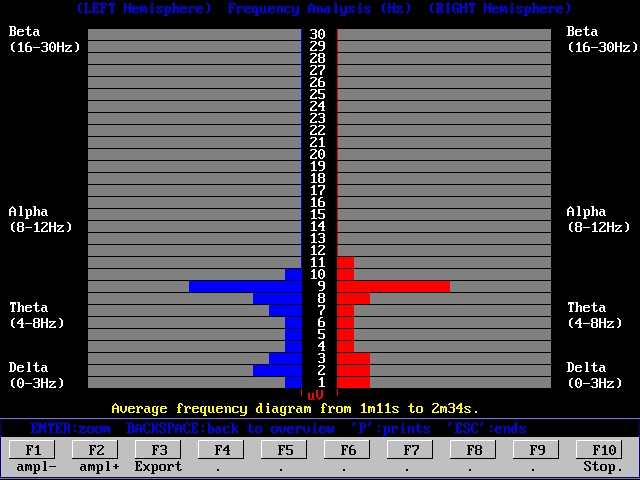
Focusing exclusively on the portion of the chart where we practised commanding the brain to enter and remain in an Alpha state, we see how powerful this wave can be over the others.
Another effect: all waves above 14 Hz that indicated brain damage have ceased. Meanwhile, the perfect balance between the hemispheres is becoming steadily more solid. Improvements achieved using Brainwave are both permanent and cumulative.

In a new, longer session, Barbara first maintained Theta waves at around 3 Hz, then kept Alpha waves at about 9 Hz for several minutes under her own control.
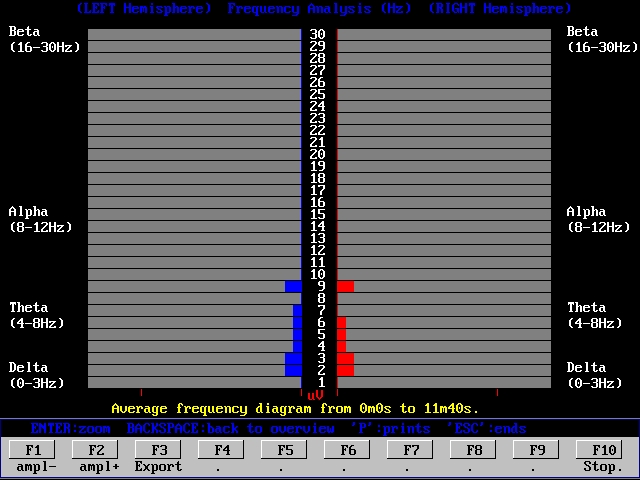
Here is the same chart viewed as an average, where Alpha and Theta waves reveal perfect hemispheric balance and deep concentration.
No wave activity above 14 Hz remains; all such issues have been resolved.
During these 12 minutes, concentration and attention were flawless.
Where is the dyslexia? Where is the hemispheric imbalance? Where is the brain damage? Dyslexia is cured, leaving only the lifelong habit of reading slowly and barely comprehending. That will be the focus of the fourth day of the course: learning to read using the “Ferrari” that the brain was always meant to be.
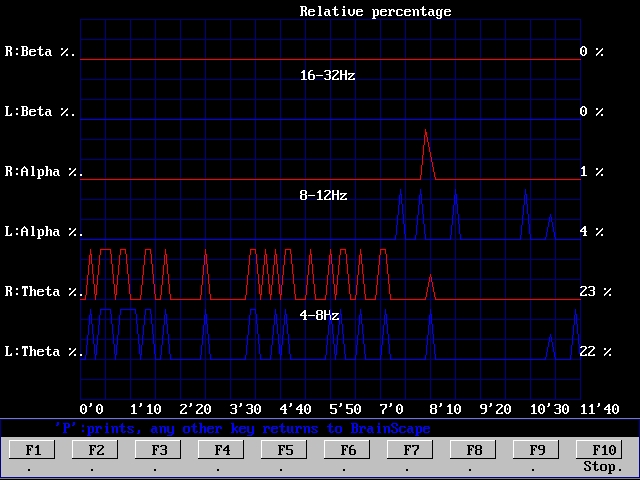
We see the same session here, represented by its relative percentages. Only a negligible and natural difference remains—3% in Alpha and 1% in Theta. This is an excellent result for someone who had a 15% difference just two days earlier.

New training: continuous Alpha waves for 12 minutes.
It is estimated that in 20 minutes of Western-style meditation, a person typically manages about 20 seconds of Alpha. The health and balance benefits are vast; if you have practised Yoga or properly guided Transcendental Meditation, you know what we mean.
Barbara, with just three days of training, was able to maintain 36 times more Alpha in 12 minutes (and could have maintained it even longer if asked) than a typical person manages in 20 minutes of meditation. Put another way, Barbara achieves in one year of daily 20-minute Alpha sessions what would take most people 60 years of meditation to accomplish in total. It’s no wonder she no longer considers herself dyslexic. Dyslexia was tackled at its root—the brain. The changes made are permanent.

This is the same session seen by its average, showing Alpha waves from 9 Hz down to 7 Hz.

The relative percentage of each wave/hemisphere is improving more and more. There were still two days left in the course. A great deal was learned during that time, but it is not presented here!
Neurofeedback and Dyslexia – Conclusion
“Reading is the pinnacle of what humans can do. It is the most complex of human functions.” These are the words that conclude the work of neurologist Dr Sally Shaywitz at the School of Medicine, Yale University, USA.
Due to its complexity, reading requires teamwork between the left and right cerebral hemispheres. When this delicate balance shifts, reading becomes difficult, slow, and seemingly pointless. Brainwave station, going straight to the heart of the dyslexia issue, teaches the brain how to achieve and maintain this state of equilibrium.
Of course, dyslexia is a broader issue than just a reading problem, but we at Alphalearning proposed that if we could improve a person’s reading ability, we could improve any other aspect. And we have achieved this in 100% of our courses.
Several lines of study comment that the dyslexic problem lies in a lack of both short- and long-term memory. Certainly. If you cannot assimilate information—whether read, heard, felt, or perceived—you obviously cannot memorise it. There is simply no information available for the brain to store. Mastering brain waves eliminates this problem because the person gains the ability to direct what the brain should do: decide and be logical, learn, be creative, memorise, recall, or rest.
In this course, mainly focused on neurofeedback and dyslexia, and specifically on the reading, memorising, and comprehension aspects, Barbara went from 168 wpm to 840 wpm, and Tania—after the final interview—went from 143 wpm to 1,420 wpm. Their comprehension levels increased as well, and with continued practice of this training, other skills will emerge. All of this was achieved in five days.
It’s all a matter of balance between the hemispheres and control of brain waves.
If you control your brain waves, you control your emotions. By controlling your emotions, you reduce stress, and by reducing stress, you can read and learn more effectively.
This is the greatest discovery of all time in the history of learning since the invention of writing.
If you have any questions about your specific case, please contact us.
Double-Blind Study
Case Study
Julia Lowes – The history of a dyslexic
James Douglas
Dr H. J. H. Richards
About dyslexia
